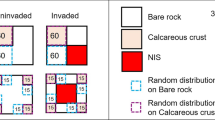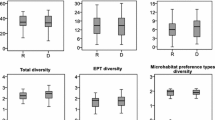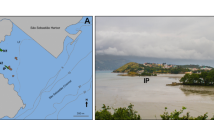Abstract
Habitat fragmentation is considered a major cause of biodiversity loss, both on terrestrial and marine environments. Understanding the effects of habitat fragmentation on the structure and dynamics of natural communities is extremely important to support management actions for biodiversity conservation. However, the effects of habitat fragmentation on marine communities are still poorly understood. Here we evaluated whether habitat fragmentation affects the structure of epifaunal communities in the sublittoral zone, in the northern coast of São Paulo state, Brazil. Five experimental landscapes were constructed, each one forming a large continuous patch. After 4 weeks, each landscape was cut on three patches of different sizes. Epifaunal macroinvertebrate communities were sampled at the edge and interior of experimental landscapes before manipulation to evaluate edge effects. After four more weeks, communities from the three patch sizes were also sampled to evaluate patch size effects. We compared the diversity of communities at different levels of fragmentation by total abundance, rarefied taxon richness, Shannon–Wiener diversity index, Simpson’s dominance index, and abundance of dominant taxa. Higher taxon richness and gastropod abundance were recorded in the patch edges, but no significant differences were found among patch sizes. We found a significant effect of habitat fragmentation, with lower abundances of Gammaridea (the dominant taxon), Ophyuroidea, and Pycnogonida after the experimental fragmentation. Lower abundances of dominant taxa resulted in higher diversity and lower dominance in fragmented landscapes when compared to integral, pre-manipulation landscapes. Our results suggest that fragmentation of landscapes in the system studied can reduce dominance, and that even small patch sizes can be important for the conservation of macroinvertebrate diversity.



Similar content being viewed by others
References
Airoldi L, Balata D, Beck MW (2008) The gray zone: relationships between habitat loss and marine diversity and their applications in conservation. J Exp Mar Biol Ecol 366:8–15
Anderson MJ (2001) A new method for non-parametric multivariate analysis of variance. Aust Ecol 26:32–46
Andrén H (1994) Effects of habitat fragmentation on birds and mammals in landscapes with different proportions of suitable habitat: a review. Oikos 71:355–366
Bell SS, Brooks RA, Robbins BD, Fonseca MS, Hall MO (2001) Faunal response to fragmentation in seagrass habitats: implications for seagrass conservation. Biol Conserv 100:115–123
Bender DJ, Contresas TA, Fahrig L (1998) Habitat loss and population decline: a meta analysis of the patch size effect. Ecology 79:517–533
Bologna PAX, Heck KL (2002) Impact of habitat edges on density and secondary production of seagrass-associated fauna. Estuaries 25:1033–1044
Boström C, Jackson EL, Simenstad CA (2006) Seagrass landscapes and their effects on associated fauna: a review. Estuar Coast Shelf Sci 68:383–403
Box GEP, Hunter WG, Hunter JS (1978) Statistics for experimenters: an introduction to design, data analysis and model building. Wiley, New York
Broadbent EN, Asner GP, Keller M, Knapp DE, Oliveira PJC, Silva JN (2008) Forest fragmentation and edge effects from deforestation and selective logging in the Brazilian Amazon. Biol Conserv 141:1745–1757
Bruna EM (1999) Seed germination in rainforest fragments. Nature 402:139
Bulleri F (2005) Experimental evaluation of early patterns of colonisation of space on rocky shores and seawalls. Mar Environ Res 60:355–374
Clarke KR (1993) Non-parametric multivariate analysis of changes in community structure. Aust J Ecol 18:117–143
Cole VJ (2010) Alteration of the configuration of bioengineers affects associated taxa. Mar Ecol Prog Ser 416:127–136
Edgar GJ (1991) Distribution patterns of mobile epifauna associated with rope fibre habitats within the Bathurst Harbour estuary, south-western Tasmania. Estuar Coast Shelf Sci 33:589–604
Eggleston DB, Etherington LL, Elis WE (1998) Organism response to habitat patchiness: species and habitat-dependent recruitment of decapod crustaceans. J Exp Mar Biol Ecol 223:111–132
Eggleston DB, Elis WE, Etherington LL, Dahlgren CP, Posey MH (1999) Organism responses to habitat fragmentation and diversity: habitat colonization by estuarine macrofauna. J Exp Mar Biol Ecol 236:107–132
Fahrig L (2003) Effects of habitat fragmentation on biodiversity. Annu Rev Ecol Evol Syst 34:487–515
Ferreira JC (2005) Diretrizes para a regeneração sócio-ambiental de áreas degradadas por mineração de saibro (caixas de empréstimo), Ubatuba, SP. Programa de pesquisa em políticas públicas—relatório parcial—fase II. Instituto Geológico—Secretaria de Estado do Meio Ambiente
Fonseca MS, Bell SS (1998) Influence of physical setting on seagrass landscapes near Beaufort, North Carolina, USA. Mar Ecol Prog Ser 171:109–121
Goodsell PJ, Connell SD (2002) Can habitat loss be treated independently of habitat configuration? Implications for rare and common taxa in fragmented landscapes. Mar Ecol Prog Ser 239:37–44
Goodsell PJ, Connell SD (2008) Complexity in the relationship between matrix composition and inter-patch distance in fragmented habitats. Mar Biol 154:117–125
Hirst JA, Atrill MJ (2008) Small is beautiful: an inverted view of habitat fragmentation in seagrass beds. Estuar Coast Shelf Sci 78:811–818
Howard RK (1985) Measurements of short-term turnover of epifauna within seagrass beds using an in situ staining method. Mar Ecol Prog Ser 22:163–168
Hurlbert SH (1971) The nonconcept of species diversity: a critique and alternative parameters. Ecology 52:577–586
Irlandi EA (1994) Large and small-scale effects of habitat structure on rates of predation: how percent coverage of seagrass affects rates of predation and siphon nipping on an infaunal bivalve. Oecologia 98:176–183
Irlandi EA, Ambrose WG, Orleo BA (1995) Landscape ecology and the marine environment: how spatial configuration of seagrass habitat influences growth and survival of the bay scallop. Oikos 72:307–313
Jacobi CM, Langevin R (1996) Habitat geometry of benthic substrates: effects on arrival and settlement of motile epifauna. Mar Ecol Prog Ser 206:39–54
Kelaher BP (2002) Influence of physical characteristics of coralline turf on associated macrofaunal assemblages. Mar Ecol Prog Ser 232:141–148
Laurance WF (2008) Theory meets reality: how habitat fragmentation research has transcended isle biogeographic theory. Biol Conserv 141:1731–1744
Laurance WF, Lovejoy TE, Vasconcelos H, Bruna E, Didham R, Stouffer P, Gascon C, Bierregaard RO, Laurance SG, Sampaio E (2002) Ecosystem decay of Amazonian forest fragments: a 22-year investigation. Conserv Biol 16:605–618
Leite FPP, Guth AZ (2003) Variações morfológicas dos estágios pós-marsupiais de Sunampithoe pelagica Milne-Edwards (Crustacea, Amphipoda, Gammaridea, Ampithoidae) da fauna de Sargassum cymosum C. Agardh. Rev Bras Zool 20:65–73
Leite FPP, Tanaka MO, Sudatti DB, Gebara RS (2007) Diel density variation of amphipods associated with Sargassum beds from two shores of Ubatuba, southeastern, Brazil. Iheringia Sér Zool 97(4):400–405
Lyra-Jorge MC, Ribeiro MC, Ciocheti G, Tambosi LR, Pivello VR (2010) Influence of multi-scale landscape structure on the occurrence of carnivorous mammals in a human-modified savanna, Brazil. Eur J Wildl Res. doi:10.1007/s10344-009-0324-x
Macreadie PI, Hindell JS, Jenkins GP, Connolly RM, Keough MJ (2009) Fish responses to experimental fragmentation of seagrass habitat. Conserv Biol 23(3):644–652
Magurran AE (2004) Measuring biological diversity. Blackwell Science, Oxford
McGarigal K, Marks BJ (1995) FRAGSTATS: spatial patterns analysis program for quantifying landscape structure. Portle: USDA, Forest Service, Pacific Northwest Res Station, p 122
Murcia C (1995) Edge effects in fragmented forests: implications for conservation. Trends Ecol Evol 10:58–62
Nohrén E, Odelgard E (2010) Response of epibenthic faunal assemblages to varying vegetation structures and habitat patch size. Aquat Biol 2:139–148
Norderhaug KM, Christie H, Rinde E (2002) Colonisation of kelp imitations by epiphyte and holdfast fauna; a study of mobility patterns. Mar Biol 141:965–973
Olabarria C (2002) Role of colonization in spatio-temporal patchiness of microgastropods in coralline turf habitat. J Exp Mar Biol Ecol 274:121–140
Presa-Abós CP, Lepori F, McKie BG, Malmqvist B (2006) Aggregation among resource patches can promote coexistence in stream-living shredders. Freshw Biol 51:545–553
Rangel TF, Diniz-Filho AF, Bini LM (2010) SAM: a comprehensive application for spatial analysis in macroecology. Ecography 33:46–50
Ries L, Sisk TD (2004) A predictive model of edge effects. Ecology 85:2917–2962
Ries L, Fletcher RJ, Battin J, Sisk TD (2004) Ecological responses to habitat edges: mechanisms, models and variability explained. Annu Rev Ecol Syst 35:491–522
Robbins BD, Bell SS (1994) Seagrass landscapes: a terrestrial approach to the marine subtidal environment. Trends Ecol Evol 9:301–304
Roberts DA, Poore AGB (2006) Habitat configuration affects colonisation of epifauna in a marine algal bed. Biol Conserv 127:18–26
Ryall KL, Fahrig L (2006) Response of predators to loss and fragmentation of habitat: a review of theory. Ecology 87:1086–1093
Salati-Filho E (2001) Condicionantes do desenvolvimento sustentável do Litoral Norte Paulista—exemplo da Bacia do Córrego da Lagoinha—Ubatuba-S.P. Tese de Doutorado. Centro de Estudos Ambientais. UNESP-Rio Claro, p 148
Silver P, Wooster D, Palmer MA (2004) Chironomid responses to spatially structured, dynamic, streambed landscapes. J N Am Benthol Soc 23:69–77
Smith TM, Hindell JS, Jenkins GP, Connolly RM (2010) Seagrass patch size affects fish responses to edges. J Anim Ecol 79:275–281
Széchy MTM, Paula EJ (2000) Padrões estruturais quantitativos de bancos de Sargassum (phaeophyta, Fucales) do litoral dos estados do Rio de Janeiro e de São Paulo, Brasil. Rev Bras Bot 23(2):121–132
Tanaka MO, Leite FPP (1998) The effect of sieve mesh-size on the abundance and composition of macrophyte-associated macrofaunal assemblages. Hydrobiologia 389:21–28
Tanaka MO, Leite FPP (2003) Spatial scaling in the distribution of macrofauna associated with Sargassum stenophyllum: variation on faunal groups, gammarid life habits and assemblage structure. J Exp Mar Biol Ecol 293:1–22
Tanaka MO, Leite FPP (2004) Distance effects on short-term recolonization of Sargassum stenophyllum by mobile epifauna, with an analysis of gammarid life habits. J Mar Biol Assoc UK 84:901–910
Tanner JE (2005) Edge effects in fauna in fragmented seagrass meadows. Aust Ecol 30:10–218
Tanner JE (2006) Landscape ecology of interactions between seagrass and mobile epifauna: the matrix matters. Estuar Coast Shelf Sci 68:404–412
Tews J, Brose U, Grimm V, Tielbörger K, Wichmann MC, Schwager M, Jeltsch F (2004) Animal species diversity driven by habitat heterogeneity/diversity: the importance of keystone structures. J Biogeogr 31:79–92
Thomaz MG, da Cunha ER (2010) The role of macrophytes in habitat structuring in aquatic ecosystems: methods of measurement, causes and consequences on animal assemblages’ composition and biodiversity. Acta Limnol Bras 22:218–236
Trebitz AS, Nibbelink N (1996) Effect of pattern of vegetation removal on growth of bluegill: a simple model. Can J Fish Aquat Sci 53:1844–1851
Tscharntke IS, Kruess A, Thies C (2002) Characteristics of insect populations on habitat fragments: a mini review. Ecol Res 17:229–239
Virnstein RW, Curran MC (1986) Colonization of artificial seagrass versus time and distance from source. Mar Ecol Prog Ser 29:279–288
Warry FY, Hindell JS, Macreadie PI, Jenkins GP, Connolly RM (2009) Integrating edge effects into studies of habitat fragmentation: a test using meiofauna in seagrass. Oecologia 159:883–892
Wiens JA (1976) Population response to patchy environments. Annu Rev Ecol Syst 7:81–129
Wiens JA (2002) Riverine landscapes: taking landscape ecology into the water. Freshw Biol 47:501–515
Wolfinger RD (1993) Covariance structure selection in general mixed models. Commun Stat Simul Comput 22:1079–1106
Zschokke S, Dolt C, Rusterholz H, Oggier C, Braschler B, Thommen GH, Ludin E, Erhardt A, Baur B (2000) Short-term responses of plants and invertebrates to experimental small-scale grassle fragmentation. Oecologia 125:559–572
Acknowledgments
The authors thank CAPES for the financial support, CNPq for a grant to M. O. Tanaka (Proc. 308630/2010-6), the staff of the Research Base “Clarimundo de Jesus” at the Institute of Oceanography of the University of São Paulo, mainly to Manoel da Cruz, Ayrton Pasquini and Fernando dos Santos, and contributions to an earlier version of the manuscript made by Luciano L. Elsinor, Luiz Eduardo Moschini, Angela Fushita, José Salatiel R. Pires, and Milton C. Ribeiro.
Author information
Authors and Affiliations
Corresponding author
Rights and permissions
About this article
Cite this article
Pierri-Daunt, A.B., Tanaka, M.O. Assessing habitat fragmentation on marine epifaunal macroinvertebrate communities: an experimental approach. Landscape Ecol 29, 17–28 (2014). https://doi.org/10.1007/s10980-013-9970-1
Received:
Accepted:
Published:
Issue Date:
DOI: https://doi.org/10.1007/s10980-013-9970-1




